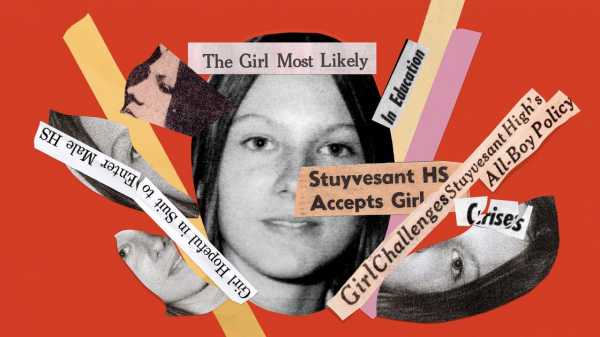
Fifty years ago this month, at a time when America was divided on questions of war, race, and gender, Alice de Rivera decided that she was fed up with her lousy high school in New York. She was thirteen, with arching eyebrows that made her look as if she was questioning everything about the world. Her father, Joseph, was a psychology professor, and her mother, Margaret, was an educational therapist; the family had moved around between college towns before settling in Brooklyn, where de Rivera enrolled in John Jay High School, the local public school. “I was good at studying and skipped third grade, which is why I was so young when I was at John Jay,” she told me, recently. She was always a bit of a tomboy, and, though shy, she was unafraid to stand up for herself. She sometimes ran her brother’s morning paper route, a job that few girls she knew undertook. As a freshman, she was named the editor of John Jay’s underground newspaper, the Streetfighter. Later, to a reporter, she described herself as “cerebral,” and argued that being smart shouldn’t hurt a girl socially. “It’s good if a boy asks you to help him with his homework,” she said.
De Rivera was especially strong in math and science, and she scored in the ninety-ninth percentile on a city-wide math examination. But John Jay was poor in those subjects, and teachers showed no interest in mentorship. She lived a twenty-minute subway ride away from Stuyvesant High School, a specialized public school in downtown Manhattan that was widely regarded as the best secondary school in the country, and one that focussed on math and science. But, since its founding, sixty-five years earlier, Stuyvesant had been all-male, so de Rivera was barred from applying. In the fall of 1968, at the student union, de Rivera met Mia Rublowsky, a tenth-grade math whiz who was also feeling stifled, and considering applying to Stuyvesant despite the sex restriction. In the lunchroom, the two of them talked about the unfairness of the system, and how to fight back. “My parents were not unmoved, but both of them, especially my mother, did not see it as an atrocity on the level of Vietnam,” de Rivera said.
The pair met with Ramona Ripston, an activist at the National Emergency Civil Liberties Committee, which had fought cases on behalf of the Black Panthers and conscientious objectors to the draft. Ripston informed the girls that Rublowsky couldn’t apply to Stuyvesant, because she was too old to transfer in, even if she were a boy. (The school accepted only freshmen and sophomores, and Rublowsky would soon be a junior.) But de Rivera was a perfect plaintiff. “As a freshman asking to transfer into a specialized high school, I was a clean case,” she said. Ripston convinced Eleanor Jackson Piel, an activist lawyer, to take on the case pro bono, and de Rivera was soon meeting regularly with the two women about her case and taking notes in a three-ring binder. Fighting educational sexual segregation was a radical idea at the time: most Ivy League universities, prep schools, and specialized public schools were still all-male. But Piel felt that barring academically talented girls from attending an élite public school violated the Fourteenth Amendment’s equal-protection clause, and intended to take the school to court.
At the women’s encouragement, de Rivera requested an application from Stuyvesant. The principal at the time was Dr. Leonard J. Fliedner, a stuffy, sixty-nine-year-old chemist who had authored the textbook “Chemistry: Man’s Servant.” Students called him the Flea. (This was also, cheekily, the name of the school’s underground newspaper.) At the school’s commencement ceremony, in 1960, after he gave an American Legion award during a period of growing counter-cultural sentiment, they booed him so loudly that it made the Times; one journalist pointed to the incident as a sign of unrest among the youth. Fliedner whacked down de Rivera’s request with a nasty letter that read, in essence, “NO GIRLS.” He later told a reporter, “It wouldn’t be just her. There would be a couple of hundred others. And we simply haven’t got the facilities. We’d need a girls’ gym and medical facilities, and a dean of women.” On January 20, 1969, de Rivera filed a lawsuit in New York against the state’s Board of Education.
Hearings for the case began in late January, and de Rivera drew immediate attention. The Daily News called her a “crusader in miniskirts,” and another paper said that anyone would believe she was sixteen. The Post described her as “looking kicky in her inevitable jeans.” “Do you think you’ll have a disruptive effect at Stuyvesant?” a student reporter asked her. “I intend to be disruptive not with my presence, but with my ideas,” she replied. By February, with hundreds of articles about her in the papers, she had become a national icon of the youth movement. After one interview, in which she said she liked rock music mixed with soul— and remarked, “My favorite used to be The Doors . . . and of course I like Jimi Hendrix”—the guitarist sent her a copy of “Electric Ladyland.” On the front, he had written, “Stay Sweet, Alice,” and, on the inside, he drew a heart and wrote, “Good luck on the school thing,” and “Love and Happiness—thanks for listening to our life and love. Jimi Hendrix.” She told me that the gift made her feel “cared about by this person who has been abstractly a wonderful spirit guide to me.”
De Rivera saved some of the newspaper clippings about her, and her insecurities as an adolescent girl are more evident there than in the court records. On one “less attractive” photo of her face in the Spanish-language daily El Diario, she scrawled, “Oh my God,” and over another from the same article she wrote, “Oh Jesus these pics have got to go.” Much of the coverage focussed less on her thoughts and more on her appearance. “One paper printed a picture of me sitting in a short skirt on a couch with legs bare and no shoes on,” she told me. “I looked at that and many of my clippings much later on and I realized the newspapers added lipstick. They sexualized me. I was only thirteen and a half. I didn’t wear lipstick!” She also started receiving calls from anonymous men, who breathed heavily on the other end of the line or said dirty things. “All very humiliating,” she told me, “but I didn't even know how to disengage.” She didn’t tell her parents.
“The morals of Stuyvesant are being corrupted!” one student wrote in an editorial for Stuyvesant’s official student paper, the Spectator. But the majority of students cheered her on. On January 21, 1969, after the first articles about the case appeared, some students proclaimed International Alice Day. Five Stuyvesant boys began showing up at her court appearances, maybe hoping to convince her to be their girlfriend. “The school’s too stuffy anyway,” one told the Daily News. Alice became friends with them, and, at one point, she told a reporter, “The boys coming to court tell me they’ve named the cafeteria Alice’s Restaurant, so I don’t expect any trouble at the school.” She began dating Michael Hill, a Stuyvesant student who called her directly after hearing about her case, and one of few African-American boys at the school. As an interracial couple in the nineteen-seventies, the couple endured looks on the subway, and hurtful comments. But he was also her first kiss, and they dated for seven years and remain friends. “In retrospect, getting the support of kids my age mattered the most,” she told me.
Back in the courtroom, beat reporters were delighted to learn that de Rivera came from a feminist family, with a great-great-grandmother, Eugenie de Rivera, who was a suffragist at the turn of the century. “Mothers, teach your daughters to keep au courant with the leading vital issues of the day,” Eugenie wrote, in 1905. “If a taste for them has been crushed out by centuries of serfdom instill into them the fact that they will help their beloved America by their intelligent vote to suppress evil and blot out corrupt politics.” In her statements, Piel drew on the President’s Commission on the Status of Women’s report, from 1963, and an article by Pauli Murray and Mary O. Eastwood called “Jane Crow and the Law,” from 1965, which formulated constitutional arguments against gender discrimination. She compared the exclusion of women from élite public schools to the exclusion of women and black people from Southern juries, and emphasized the fact that the white liberal men in the room supported civil rights but were blind to the sexual discrimination in their back yards. At one point, to gasps in the courtroom, she pointed out that John Doar, the president of the Board of Education, which was fighting to keep de Rivera out of Stuyvesant, had once represented James Meredith in his famous quest to become the first black student admitted to the University of Mississippi. Doar evidently believed that gender discrimination was not an equal crime to racial injustice.
The first judge assigned to the case, Irving Levey, was not sympathetic to de Rivera’s request. He only reluctantly let her take the admittance test for specialized public schools, worrying that she would be uncomfortable as the only girl in the room, and too much of a distraction to the boys. But, by April, a new judge, Jawn A. Sandifer, had been assigned to the case. Sandifer had been barred from Duke Law School because he was black, and had studied instead at Howard University. He had gone on to become the president of the New York chapter of the National Association for the Advancement of Colored People, where he worked closely with Thurgood Marshall. In 1950, he had successfully argued a case before the Supreme Court that had forced railroad dining cars to racially integrate. According to notes held at Harvard from the feminist activist Catherine Snipe East, who observed the trial, Sandifer then made “life difficult” for the school board’s lawyers, barring lines of questioning that he deemed sexist and irrelevant. In May, just before the case was decided, and perhaps to avoid a public defeat, the education board voluntarily repealed Stuyvesant’s sex restriction. “At first I was upset they settled because I thought it would be a precedent not applied in others,” de Rivera told me. But, she added, “It was a cultural precedent. Only later did I understand it to be historically important.”
On a cold day in January, I travelled to visit de Rivera at her house in Auburn, Maine. “It might be a little hard to get to me,” she warned, by phone. That was not an exaggeration. De Rivera lives in a farmstead that was built in the eighteen-twenties, far outside of town, and hidden among the trees. My Uber driver went back and forth several times before de Rivera, a trim sixty-three-year-old in a plaid flannel shirt, walked down the snowy road to find me. She was instantly recognizable from her old, teen-age press photos. She brought me inside, and we sat at her kitchen table near an old Jøtul wood stove that was heating the room. De Rivera is a physician, and she lives with her husband, David Haines, a retired math professor at Bates College. (She now goes by Alice Chartrand Haines, which includes her first husband’s last name.) After her courtroom victory, she had become a footnote in history, and hadn’t spoken to the press since 1969. When I saw her, I told her that some New York City girls wonder whether she was a myth.
“Oh, I’m real,” she said, possibly blushing. “Just very private.”
Increasing her legend was that the fact that, like Moses, who never entered the promised land, de Rivera never actually attended Stuyvesant. Soon after the decision, de Rivera’s parents moved the family to an off-the-grid, thirty-five-acre commune in upstate New York, and de Rivera lost touch with her friends. (Though, on July 20th of that year, the family drove down to Central Park to watch the moon landing on a large screen with thousands of other spectators.) “I was disappointed that I couldn’t go,” she told me. “But how could I, from so far away? There was some discussion if I could stay in the city or even commute. My parents thought I was going to be the only girl, and maybe that was going to be harmful. I gave in.”
In the fall of 1969, thirteen daring girls enrolled in Stuyvesant. (None of them knew how many they were entering with, and all assumed that there would be dozens of other girls.) Despite four months’ notice, the Flea had not bothered to ready the most basic things, and, a week before school started, had to commandeer the third-floor boys’ restroom for the girls. The urinals were boarded up with plywood, and provided a good place to sit and chat. They were given an auxiliary gym, and not allowed into the main one. Some of their experiences were harrowing, including verbal abuse from female teachers who did not think they were feminine enough, and sexual harassment from male teachers. But, the following year, more than two hundred girls enrolled. In the next few years, all of New York’s same-sex public schools, including Brooklyn Tech and Boys High, went coed. Yale and Princeton went coed later that year, and, within the next several years, Harvard, Brown, and Dartmouth followed suit, as did prep schools like Andover, Phillips Exeter, and Boston Latin. I attended Stuyvesant eleven years later, when forty per cent of the students were female. More than ten thousand girls have now attended, including the actress Lucy Liu, the string theorist Lisa Randall, and the feminist writer Jessica Valenti.
The anniversary of de Rivera’s battle comes amid another controversy about diversity at Stuyvesant. The school accepts students based entirely on an entrance exam, and the result is that few black and Latino students are admitted. (Only ten black students were admitted to Stuyvesant’s incoming class last year.) Last year, Mayor Bill de Blasio proposed eliminating the test for all of the specialized public schools in the city and offering admission to the top seven per cent of students in each district, insuring more diverse enrollment. Stuyvesant is currently seventy-three per cent Asian, and many Asian-Americans feel that the proposal is an attack on their community. De Rivera is disheartened by the low numbers of black and Latinos at specialized schools, and feels that racism is still built into the educational system, just as sexism was. She points out that Bates has eliminated mandatory reporting of S.A.T. scores from its admissions process. “How do we get those numbers up?” she said. “Taking a percentage of high achievers from each district makes moral sense.”
De Rivera opened a clinic in Lewiston, Auburn’s twin city, in 2012, and, in the afternoon, we drove there for a visit. The office, at eighteen by fifteen feet, is cramped. Seventy per cent of de Rivera’s clients are from Lewiston’s large population of Somali refugees. On the wall, a sign warned that hookah tobacco, which is popular among Somalis, may smell like fruit and chocolate but is as dangerous as cigarettes. Next to the sign were her medical degrees, and an honorary degree from Stuyvesant. She also runs a clinic at the Trinity Jubilee Center, a charity that serves people who can’t pay for medical care, including the homeless and recently arrived asylum seekers. Many of her patients were traumatized during the Somali civil war, and many of the women were raped. “I see a lot of P.T.S.D.,” de Rivera said.
Our afternoon was cut short by a call requesting de Rivera’s medical help. “Dr. Haines here,” she said as she answered the phone. She offered to drive me to the Bates campus, and we headed to her car, which has a license plate that reads, “DR. ALICE.” On our way to Bates, she reflected that she was proud to have fought to integrate Stuyvesant, but also happy that she hadn’t attended. She worried that having to fight to prove herself might have made her obsess over grades and competition instead of focussing on personal growth. “When you are trying to do something, you could go overboard,” she said. “The alternative path allowed me to explore alternative parts of myself: outdoors, politics, poetry, things out of the limelight. Possibly, if I had been in the competitive culture of Stuyvesant, I would have been a different kind of doctor.”
Sourse: newyorker.com






